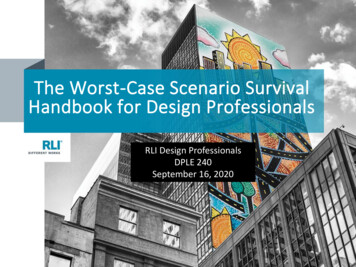
Transcription
The Worst-Case Scenario SurvivalHandbook for Design ProfessionalsRLI Design ProfessionalsDPLE 240September 16, 2020
RLI Design Professionals is a Registered Provider withThe American Institute of Architects Continuing Education Systems.Credit earned on completion of this program will be reported toCES Records for AIA members. Certificates of Completionfor non-AIA members are available on request.This program is registered with the AIA/CES for continuing professional education.As such, it does not include content that may be deemed or construed to bean approval or endorsement by the AIA of any material of construction orany method or manner of handling, using, distributing, or dealingin any material or product. Questions related to specific materials,methods, and services will be addressed at the conclusion ofthis presentation.
Copyright MaterialsThis presentation is protected by US and International Copyright laws.Reproduction, distribution, display and use of the presentation withoutwritten permission of the speakers is prohibited. RLI Design Professionals
DisclaimerRLI makes no warranty as to the accuracy, completeness or currency of the content of this presentation.The information in this presentation is provided solely for the purpose of providing general referenceinformation and for education purposes only. Nothing in this presentation should be construed as anoffer of insurance or any particular terms of coverage. Nothing herein is a guarantee of coverage, normay this presentation be relied on or considered for any future determination of coverage.Nothing presented herein is a substitute for actual legal advice that can only be provided in the eventthat an attorney client relationship is formed and agreed to by both the attorney and the client.Furthermore, the presentation may involve hypothetical facts and is no substitute for legal advice basedon the actual facts and circumstances of a particular situation.
Course DescriptionFor most design professionals,the “worst-case scenario” is a substantialprofessional liability claim. Evaluating past claimsallows us to evaluate what went wrong and howpublic health, safety and welfare may have beencompromised—almost always inadvertently.Errors originate in proposed contracts;in interpretation of laws, codes, and regulations;in lender-requested documents; or in other ways.This course will address how these issues can beidentified, assessed, and mitigated—for the protection of all.
Learning ObjectivesParticipants will learn how:1234Interpretation of codes can result in significant exposures fordesign professionals and their clients;The legal process works and what rights each party has in it;Contracts and other communications can more clearly address theseconcerns to protect the parties as well as the public; andOwners, lenders, and other parties may need explanations fromtheir design professionals about the risks and uncertainties of thedesign process.
Interpretation of Codes
Interpretation of CodesIssues include:CONTRACT FOR PROFESSIONAL SERVICES Consultant shall comply with all laws, codes,ordinances, rules, regulations, orders and otherlegal requirements.
Interpretation of CodesThe ExplanationPROBLEMS include: Elevating the standard of care—maybe to an unattainable level. Insuring an elevated standard of care. Conflicting laws, codes, ordinances, rules, regulations, orders,and requirements. Changing laws, codes, ordinances, rules, regulations, ordersand requirements. Applying the laws, codes, ordinances, rules, regulations, orders,and requirements to the specific services being provided.
Interpretation of CodesExample: ADA Standards Many state codes are based on national models, but therecan be significant variations among the state and local coderequirements.Design and construction under state and local codescomply with the ADA only when the codes provideaccessibility that equals or exceeds the ADA requirements.When these laws are inconsistent, the burden falls onowners and design professionals to determine compliancewith both federal and state laws.https://www.asla.org/universaldesign.aspx https://www.ada.gov/certcode.htm
Enforcement of CodesDifferent Authorities The enforcement of state codes is the responsibility ofstate or local officials – usually through plan reviews andinspections. The ADA relies on civil rights enforcement through litigationin federal courts. Local officials do not have the authority to enforce the ADAon behalf of the federal government.https://www.ada.gov/certcode.htm
Compliance with CodesEfforts to FacilitateThe ADA authorizes the Department of Justice, upon request ofstate or local officials, to certify that state or local accessibilitylaws meet or exceed the requirements of the ADA.This does NOT:BUT: Delegate ADA enforcementauthority to the states. Eliminate an individual's rightto seek relief through thefederal courts. Effective enforcement of a certifiedcode can mitigate the need forfederal enforcement if new oraltered facilities are accessible. If a lawsuit is filed, compliance witha certified code may be offered asrebuttable evidence of compliancewith the ADA.https://www.ada.gov/certcode.htm
Resources and TipsContract Considerations§3.2.1 The Architect shall review the program and other information furnished by theOwner, and shall review laws, codes, and regulations applicable to the Architect’sservices.§4.2.1 Upon recognizing the need to perform the following Additional Services, theArchitect shall notify the Owner with reasonable promptness and explain the facts andcircumstances giving rise to the need. The Architect shall not proceed to provide thefollowing Additional Services until the Architect receives the Owner’s writtenauthorization: .2 Services necessitated by the enactment or revision of codes, laws, or regulations,including changing or editing previously prepared Instruments of Service.3 Changing or editing previously prepared Instruments of Service necessitated by officialinterpretations of applicable codes, laws or regulations that are either (a) contrary to specificinterpretations by the applicable authorities having jurisdiction made prior to the issuance ofthe building permit, or (b) contrary to requirements of the Instruments of Service when thoseInstruments of Service were prepared in accordance with the applicable standard of care .AIA Document B101-2017
The Legal Process and Rights
ACEC/AIA/NSPE Professional Liability SurveyThe IssuesSource: /pdfs/liability/Survey-Results-Final-2019.pdf
ACEC/AIA/NSPE Professional Liability SurveyThe IssuesSource: /pdfs/liability/Survey-Results-Final-2019.pdf
Summary Observations on ClaimsUnderwriters are seeing concerns with:Condos, Residential Subdivisions,and other Habitational ProjectsGeotechnical ServicesStructural Engineering ServicesTraffic Planning, Control, Signaling,and EngineeringPipeline Design and InspectionSchool and University ProjectsSustainable DesignSource: /pdfs/liability/Survey-Results-Final-2019.pdf
Legal Process and Rights: Dispute ResolutionEJCDC E-500-2020—§6.07 Dispute Resolution (summarized)1 Negotiate all disputes in good faith—30 days.2 Mediate unsettled disputes—120 days.3 If still unsettled, either: Arbitrate LitigateEJCDC Document E-500-2020
Dispute Resolution: Issues to Weigh No Dispute ResolutionMethod Selected in Advance Arbitration Consolidated Proceedings Waiver of Jury Trial “Home Field” Advantage Unfamiliar Venues Negotiation or Mediation asFirst Step Clear Rules: AAA JAMS Governing LawAdvice: Check with your Attorney!
Contracts and Communicationsto Address Concerns
Documentation for Your DefensePrinciples of Good ContractsScope Definition: Issues Unknown Conditions Hazardous Materials Services by Others Geotechnical Engineering Surveying “Construction Administration” Inspection Means and Methods Safety Undefined Submittal Review Warranties and Guarantees StudiesPre-Planning ServicesDesign Phase ServicesProcurement Phase ServicesConstruction Phase Services Observation Responsibilities of Others Eye on Completed Project Excluded Services Supplemental/AdditionalServices
Documentation for Your DefensePrinciples of Good ContractsInnovative Design: Issues Products Rushed to Marketwithout Adequate Testingfor: Environment Longevity False Advertising Existing Products orTechnologies with New Uses Objective Information fromManufacturers and Suppliers,including: Warnings of Adverse Effects Case Studies/Examples References Pro/Con Analysis Contractor Qualifications
Documentation for Your DefensePrinciples of Good ContractsTiming: Issues Inadequate Schedules No “Right to Rely” onExisting Information Differences in Conditions Poor Submittal Schedules/Schedules Not Followed “Time is of the Essence” One-Sided Suspensions Allowances for CircumstancesBeyond your Control: Client Review Consultant Coordination AHJ Review Contractor Delays Force Majeure, includingpandemics and epidemics Notice of Contractor Claims
Documentation for Your DefensePrinciples of Good ContractsLimitations of Liability: Issues One-Sided in Favor of theOther Party Non-reciprocal baragainst going afterclients personally Unwillingness to limitliability, even toinsurance proceeds Mutual Waiver of ConsequentialDamages Limitation of Liability to: Fee Multiple of the Fee Specific Dollar Amount Available Insurance s/pdf/dple/dple213.pdf
Complexity of Contractual IssuesExample: Consequential Damages Loss of useLost opportunitiesLost incomeLost profitLost financing vehiclesDamage to business or reputationLost management or employee productivity
Documentation for Your DefenseContracts, Actions, and DocumentationContracts Clear scope of servicesNo responsibility to inspect work for safety concerns or control/authority todirect the means and methodsNo right or duty to stop workOn Site Actions Selectively choose meetings Don’t direct contractor on how to do their job Report safety concerns to party in charge and follow-up with documentationDocumentation & Records Keep and maintain detailed recordsContract, notes, correspondence, field logs, etc.
Explanations to Owners,Lenders, and Other Parties
Lender Consent FormsIssues include:ASSIGNMENT OF AGREEMENT AND CONSENT If, following an Event of Default under the Loan Documents, Agent, on behalf ofLenders, any Lender, any purchaser at a foreclosure sale of the Improvementsor transferee by deed-in-lieu of foreclosure (each a “Successor”), shall elect atany time to complete any or all of the Improvements, any Successor may usePlans and the ideas, designs and concepts contained in the Plans inconnection with such completion without payment of any additional fees orcharges to Design Professional for such use.
Documentation for Your DefenseExplanationsWhat Does Your Contract Say About:Ownership and Reuse of Instruments of Service?Representations and Warranties?Notices to the Lender?
Resources and TipsContract Considerations§10.3 Neither the Owner nor the Architect shall assign this Agreementwithout the written consent of the other, except that the Owner mayassign this Agreement to a lender providing financing for the Project if thelender agrees to assume the Owner’s rights and obligations under thisAgreement, including any payments due to the Architect by the Ownerprior to the Assignment.§10.4 If the Owner requests the Architect to execute consentsreasonably required to facilitate assignment to a lender, the Architect shallexecute all such consents that are consistent with this Agreement,provided that the proposed consent is submitted to the Architect forreview at least 14 days prior to execution AIA Document B101-2017
Other Resources and Tips
Documentation for Your DefenseResourcesCircumstanceAn event or occurrence from which an Insuredreasonably expects that a Claim could be made.When in doubt, report it!
A New Resource for RLI Insureds: DPLEs on Demand!Visit the RLI Resource LearningCenter:http://www.RLIRLC.com(You can “Add to favorites” for easier future access!)Accessing your account is simple— Find your activation email from:customerservice@enquironensights.com Your username is the email address that’s on file with RLI Call 877-568-6655 for help with setup or to reset your passwordPowered by:
Thank you for your time!Questions?This concludes The American Institute of ArchitectsContinuing Education Systems Program
RLI Design Professionals DPLE 240 September 16, 2020 The Worst-Case Sce










